African leopard
| African leopard | |
|---|---|
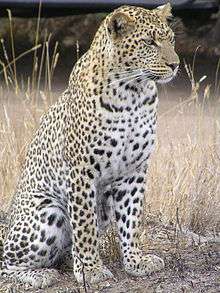 | |
| African leopard in Serengeti, Tanzania | |
| Scientific classification | |
| Kingdom: | Animalia |
| Phylum: | Chordata |
| Class: | Mammalia |
| Order: | Carnivora |
| Suborder: | Feliformia |
| Family: | Felidae |
| Subfamily: | Pantherinae |
| Genus: | Panthera |
| Species: | P. pardus |
| Subspecies: | P. p. pardus[1] |
| Trinomial name | |
| Panthera pardus pardus[1] | |
The African leopard (Panthera pardus pardus) is the leopard nominate subspecies native to many countries in Africa. It is widely distributed in most of sub-Saharan Africa, but the historical range has been fragmented in the course of habitat conversion.[2] Leopards have been recorded in North Africa as well.[3][4]
Taxonomy
Traditionally the following subspecies were recognized in Africa:[5]
- Central African leopard P. p. pardus (Linnaeus, 1758) – Sudan and northeastern Democratic Republic of Congo
- Barbary leopard P. p. panthera (Schreber, 1777) – North Africa
- West African forest leopard P. p. leopardus (Schreber, 1777) – Rain forests of Western and Central Africa
- Cape leopard P. p. melanotica (Günther, 1885) – Southern Africa
- East African leopard P. p. suahelica (Neumann, 1900) – East Africa
- Somali leopard P. p. nanopardus (Thomas, 1904) – Arid zones of Somalia
- Ruwenzori leopard P. p. ruwenzori (Camerano, 1906) – Ruwenzori and Virunga Mountains
- Abyssinian leopard P. p. adusta (Pocock, 1927) – Ethiopian Highlands
- West African leopard P. p. reichenovi (Cabrera, 1927) – Savannas of Cameroon
- Zanzibar leopard P. p. adersi (Pocock, 1932) – Unguja Island, Zanzibar
Results of genetic analysis indicate that all African leopard populations are closely related and represent only one subspecies. However, sample sizes were limited.[4]
Characteristics
).jpg)
The African leopard exhibits great variation in coat color, depending on location and habitat. Coat colour varies from pale yellow to deep gold or tawny, and sometimes black, and is patterned with black rosettes while the head, lower limbs and belly are spotted with solid black. Male leopards are larger, averaging 60 kg (130 lb) with 91 kg (201 lb) being the maximum weight attained by a male. Females weigh about 35 to 40 kg (77 to 88 lb) on average.
The African leopard is sexually dimorphic; males are larger and heavier than females.[6] Between 1996 and 2000, 11 adult leopards were radio-collared on Namibian farmlands. Males weighed 37.5 to 52.3 kg (83 to 115 lb) only, and females 24 to 33.5 kg (53 to 74 lb).[7] The heaviest known leopard weighed about 96 kg (212 lb), and was recorded in South West Africa.[8]
According to Alfred Edward Pease, black leopards in North Africa were similar in size to lions. An Algerian leopard killed in 1913 was reported to have measured approximately 8 ft 10 in (2.69 m), before being skinned.[9]
Leopards inhabiting the mountains of the Cape Provinces appear physically different from leopards further north. Their average weight may be only half that of the more northerly populations,[10] apart from that of Somalia in East Africa.[11]
Distribution and habitat
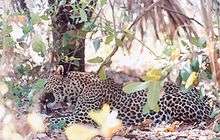
Leopards inhabited a wide range of habitats within Africa, from mountainous forests to grasslands and savannahs, excluding only extremely sandy desert. They are most at risk in areas of semi-desert, where scarce resources often result in conflict with nomadic farmers and their livestock.[12][13]
Leopards used to occur in most of sub-Saharan Africa, occupying both rainforest and arid desert habitats. They were found in all habitats with annual rainfall above 50 mm (2.0 in), and can penetrate areas with less than this amount of rainfall along river courses. They range exceptionally up to 5,700 m (18,700 ft), have been sighted on high slopes of the Ruwenzori and Virunga volcanoes, and observed when drinking thermal water 37 °C (99 °F) in the Virunga National Park.[13]
They appear to be successful at adapting to altered natural habitat and settled environments in the absence of intense persecution. There were many records of their presence near major cities. But already in the 1980s, they have become rare throughout much of West Africa.[14] Now, they remain patchily distributed within historical limits.[2]
Leopards are rare in northern Africa. A relict population persists in the Atlas Mountains of Morocco, in forest and mountain steppe in elevations of 300 to 2,500 m (980 to 8,200 ft), where the climate is temperate to cold.[15][16]
In 2014, a leopard was killed in the Elba Protected Area in southeastern Egypt. This was the first sighting of a leopard in the country since the 1950s.[17]
In 2016, a leopard was recorded for the first time in a semi-arid area of Yechilay in northern Ethiopia.[18]
Ecology and behavior

Leopards are generally most active between sunset and sunrise, and kill more prey at this time.[19] In Kruger National Park, male leopards and female leopards with cubs were more active at night than solitary females. The highest rates of daytime activity were recorded for leopards using thorn thickets during the wet season, when impala also used them.[20]
The leopard has an exceptional ability to adapt to changes in prey availability, and has a very broad diet. Small prey are taken where large ungulates are less common. The known prey of leopards ranges from dung beetles to adult elands, which can reach 900 kg (2,000 lb).[13] In sub-Saharan Africa, at least 92 prey species have been documented in leopard scat including rodents, birds, small and large antelopes, hyraxes and hares, and arthropods. They generally focus their hunting activity on locally abundant medium-sized ungulates in the 20 to 80 kg (44 to 176 lb) range, while opportunistically taking other prey. Average intervals between ungulate kills range from seven[20] to 12–13 days.[19]
Leopards often hide large kills in trees, a behavior for which great strength is required. There have been several observations of leopards hauling carcasses of young giraffe, estimated to weigh up to 125 kg (276 lb), i.e. 2–3 times the weight of the leopard, up to 5.7 m (19 ft) into trees.[19]
In the Serengeti National Park, leopards were radio-collared for the first time in the early 1970s. Their hunting at night was difficult to watch; the best time for observing them was after dawn. Of their 64 daytime hunts only three were successful. In this woodland area, they preyed mostly on impala, both adult and young, and caught some Thomson's gazelless in the dry season. Occasionally, they successfully hunted warthog, dik-dik, reedbuck, duiker, steenbok, wildebeest and topi calves, jackal, Cape hare, guinea fowl and starling. They were less successful in hunting zebras, kongonis, giraffes, mongooses, genets, hyrax and small birds. Scavenging from the carcasses of large animals made up a small proportion of their food.[21] In tropical rainforest in Central Africa, their diet consists of duikers and primates. Some individual leopards have shown a strong preference for pangolins and porcupines.[22] In the Dzanga-Sangha region in the Central African Republic a leopard reportedly attacked and pursued a large gorilla, but did not catch it. Gorilla parts found in leopard scat indicates that the leopard either scavenged on gorilla remains or killed it.[23]
Leopard diet includes reptiles, and they will occasionally take domestic livestock when other food is scarce. Leopards are very stealthy and like to stalk close and run a relatively short distance after their prey. They kill through suffocation by grabbing their prey by the throat and biting down with their powerful jaws. They rarely fight other predators for their food.
In North Africa, the leopard preys on Barbary macaque.[24][25]
Attacks on humans
Threats
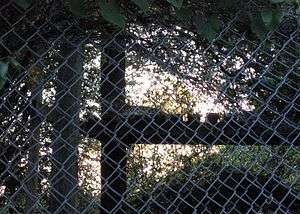
Throughout Africa, the major threats to leopards are habitat conversion and intense persecution,[26] especially in retribution for real and perceived livestock loss.[27]
The impact of trophy hunting on populations is unclear, but may have impacts at the demographic and population level, especially when females are shot. In Tanzania, only males are allowed to be hunted, but females comprised 28.6% of 77 trophies shot between 1995 and 1998.[28] Removing an excessively high number of males may produce a cascade of deleterious effects on the population. Although male leopards provide no parental care to cubs, the presence of the sire allows females to raise cubs with a reduced risk of infanticide by other males. There are few reliable observations of infanticide in leopards, but new males entering the population are likely to kill existing cubs.[29]
Analysis of leopard scats and camera trapping surveys in contiguous forest landscapes in the Congo Basin revealed a high dietary niche overlap and an exploitative competition between leopards and bushmeat hunters. With increasing proximity to settlements and concomitant human hunting pressure, leopards exploit smaller prey and occur at considerably reduced population densities. In the presence of intensive bushmeat hunting surrounding human settlements, leopards appear entirely absent.[30]
Conservation
Panthera pardus is listed in CITES Appendix I.[2]
Protected areas in Africa, where leopard populations are present, include:
Gallery
.jpg)
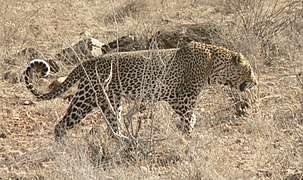 Male leopard in Samburu National Reserve, Kenya
Male leopard in Samburu National Reserve, Kenya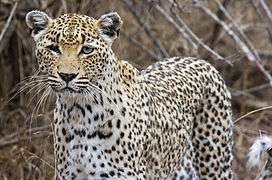 An African leopard in Kruger National Park, South Africa
An African leopard in Kruger National Park, South Africa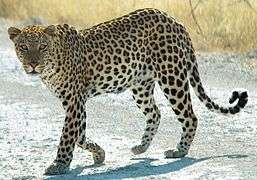 Leopard in Etosha National Park, Namibia
Leopard in Etosha National Park, Namibia
See also
Leopard subspecies: Arabian leopard · Anatolian leopard · Persian leopard · Indian leopard · Amur leopard · Indochinese leopard · Javan leopard · Sri Lankan leopard · European Ice Age leopard
References
- 1 2 Wilson, D.E.; Reeder, D.M., eds. (2005). Mammal Species of the World: A Taxonomic and Geographic Reference (3rd ed.). Johns Hopkins University Press. ISBN 978-0-8018-8221-0. OCLC 62265494.
- 1 2 3 Stein, A. B.; Athreya, V.; Gerngross, P.; Balme, G.; Henschel, P.; Karanth, U.; Miquelle, D.; Rostro, S.; Kamler, J. F.; Laguardia, A. (2016). "Panthera pardus". IUCN Red List of Threatened Species. Version 2016.2. International Union for Conservation of Nature.
- ↑ Miththapala, Sriyanie; Seidensticker, John; O'Brien, Stephen J. (1996). "Phylogeographic Subspecies Recognition in Leopards (Panthera pardus): Molecular Genetic Variation". Conservation Biology. 10 (4): 1115–1132. doi:10.1046/j.1523-1739.1996.10041115.x. ISSN 0888-8892.
- 1 2 Uphyrkina, O.; Johnson, E.W.; Quigley, H.; Miquelle, D.; Marker, L.; Bush, M.; O'Brien, S. J. (2001). "Phylogenetics, genome diversity and origin of modern leopard, Panthera pardus" (PDF). Molecular Ecology. 10 (11): 2617–2633. doi:10.1046/j.0962-1083.2001.01350.x. PMID 11883877.
- ↑ Sunquist, M. E.; Sunquist, F. C. (2009). "Family Felidae (Cats)". In Wilson, Don E.; Mittermeier, Russell A. Handbook of the Mammals of the World: Carnivores. Vol 1. Lynx Ediciones. p. 137. ISBN 978-84-96553-49-1.
- ↑ Hoath, Richard (2009). A Field Guide to the Mammals of Egypt. American Univ in Cairo Press. pp. 106–107. ISBN 978-977-416-254-1.
- ↑ Marker, L. L.; Dickman, A. J. (October 2005). "Factors affecting leopard (Panthera pardus) spatial ecology, with particular reference to Namibian farmlands" (PDF). South African Journal of Wildlife Research. 35 (2): 105–115. hdl:10520/EJC117223. ISSN 2410-7220.
- ↑ Brain, C. K. (August 1983). The Hunters Or the Hunted?: An Introduction to African Cave Taphonomy. University of Chicago Press. pp. 84–102. ISBN 978-0-226-07090-2.
- ↑ Pease, A. E. (1913). "Of dangerous game". The Book of the Lion. London: John Murray. pp. 46−68.
- ↑ Martins, Quinton; Martins, Nicole (2006). "Leopards of the Cape: conservation and conservation concerns". International Journal of Environmental Studies. 63 (5): 579–585. doi:10.1080/00207230600963486. ISSN 0020-7233.
- ↑ Brakefield, Tom (1993). "Leopard: The Super Cat?". Big Cats. Voyageur Press. pp. 82–. ISBN 978-1-61060-354-6.
- ↑ Kirby, F. V. (1899). "The Leopard (Felis pardus)". In Bryden, H. A. Great and small game of Africa. London: Rowland Ward Ltd. pp. 568–574.
- 1 2 3 Nowell, K.; Jackson, P. (1996). "Leopard Panthera pardus". Wild Cats: Status Survey and Conservation Action Plan (PDF). Gland, Switzerland: IUCN/SSC Cat Specialist Group. pp. 1–334. ISBN 2-8317-0045-0.
- ↑ Martin, R. B. and de Meulenaer, T. (1988). Survey of the status of the leopard (Panthera pardus) in sub-Saharan Africa. CITES Secretariat, Lausanne.
- ↑ Cuzin, F. (2003). Les grands mammifères du Maroc méridional (Haut Atlas, Anti Atlas et Sahara): Distribution, Ecologie et Conservation (PDF). Université Montpellier II: Ph.D. Thesis, Laboratoire de Biogéographie et Ecologie des Vertèbrés, Ecole Pratique des Hautes Etudes.
- ↑ Busby, G. B. J., Gottelli, D., Durant, S., Wacher, T., Marker, L., Belbachir, F., de Smet, K., Belbachir-Bazi, A., Fellous, A. and Belghoul, M. (2006). "Part 5: Using Molecular Genetics to study the presence of Endangered carnivores". A Report from the Sahelo Saharan Interest Group. Algeria: Parc National de l'Ahaggar Survey.
- ↑ Soultan, A.; Attum, O.; Hamada, A.; Hatab, E.-B.; Ahmed, S. E.; Eisa, A.; Sharif, I. A.; Nagy, A.; Shohdi, W. (2017). "Recent observation for leopard Panthera pardus in Egypt". Mammalia. 81 (1): 115–117. doi:10.1515/mammalia-2015-0089.
- ↑ Westerberg, Matthew; Craig, Evan; Meheretu, Yonas (2017). "First record of African leopard (Panthera pardus pardus L.) in semi-arid area of Yechilay, northern Ethiopia". African Journal of Ecology. doi:10.1111/aje.12436. ISSN 0141-6707.
- 1 2 3 Hamilton, Patrick Hume (1976). The Movements of Leopards in Tsavo National Park, Kenya as Determined by Radio-tracking (Thesis). University of Nairobi.
- 1 2 Bailey, Theodore N. (2005) [1993]. The African Leopard: Ecology and Behavior of a Solitary Felid. Blackburn Press. ISBN 978-1-932846-11-9.
- ↑ Bertram, B (1974), "Radio-Tracking Leopards in the Serengeti", African Wildlife Leadership Foundation News 1974 (9), pp. 8–10
- ↑ Jenny, D. (1993). "Leopard research in Ivory Coast rain forest". Cat News (18): 12–13.
- ↑ Fay, J. M.; Carroll, R.; Kerbis Peterhans, J. C.; Harris, D. (1995). "Leopard attack on and consumption of gorillas in the Central African Republic". Journal of Human Evolution. 29 (1): 93–99. doi:10.1006/jhev.1995.1048.
- ↑ Fa, J. E. (1982). "A survey of population and habitat of the Barbary macaque Macaca sylvanus L. in north Morocco". Biological Conservation. 24 (1): 45–66. doi:10.1016/0006-3207(82)90046-5.
- ↑ Van Lavieren, E. (2012). "The Barbary Macaque (Macaca sylvanus); A unique endangered primate species struggling to survive" (PDF). Revista Eubacteria (30): 1–4. ISSN 1697-0071.
- ↑ Williams, Samual T.; Williams, Kathryn S.; Lewis, Bradley P.; Hill, Russell A. (2017). "Population dynamics and threats to an apex predator outside protected areas: implications for carnivore management". Royal Society Open Science. 4 (4): 161090. doi:10.1098/rsos.161090. ISSN 2054-5703.
- ↑ Ray, Justina C.; Hunter, Luke; Zigouris, Joanna (2005). Setting Conservation and Research Priorities for Larger African Carnivores (PDF). New York: Wildlife Conservation Society.
- ↑ Spong, G.; Johansson, M.; Björklund, M. (2000). "High genetic variation in leopards indicates large and long-term stable effective population size". Molecular Ecology. 9 (11): 1773–1782. doi:10.1046/j.1365-294x.2000.01067.x. ISSN 0962-1083.
- ↑ Cat Specialist Group (2005). Cat Project of the Month – November 2005: Conservation biology of leopards (Panthera pardus) in a fragmented landscape; spatial ecology, population biology and human threats. IUCN/SSC Cat Specialist Group
- ↑ Henschel, P.; Hunter, L. T. B.; Coad, L.; Abernethy, K. A.; Mühlenberg, M. (2011). "Leopard prey choice in the Congo Basin rainforest suggests exploitative competition with human bushmeat hunters" (PDF). Journal of Zoology: no–no. doi:10.1111/j.1469-7998.2011.00826.x. ISSN 0952-8369. Archived from the original (PDF) on 2012-03-15.
- ↑ Henschel, P.; Abernethy, K. A.; White, L. J. T. (2005). "Leopard food habits in the Lope National Park, Gabon, Central Africa". African Journal of Ecology. 43 (1): 21–28. doi:10.1111/j.1365-2028.2004.00518.x. ISSN 0141-6707.
- ↑ Jenny, D. (1996). "Spatial organization of leopards Panthera pardus in Taï National Park, Ivory Coast: is rainforest habitat a 'tropical haven'?". Journal of Zoology. 240 (3): 427–440. doi:10.1111/j.1469-7998.1996.tb05296.x.
- ↑ Maputla, Nakedi W.; Chimimba, Christian T.; Ferreira, Sam M. (2013). "Calibrating a camera trap-based biased mark-recapture sampling design to survey the leopard population in the N'wanetsi concession, Kruger National Park, South Africa". African Journal of Ecology. 51 (3): 422–430. doi:10.1111/aje.12047. ISSN 0141-6707.
External links
| Wikimedia Commons has media related to Panthera pardus pardus. |
| Wikispecies has information related to Panthera pardus pardus |
- Species portrait African leopard; IUCN/SSC Cat Specialist Group
- Leopards .:. wild-cat.org — Information about research and conservation of leopards
- The Cape Leopard Trust, South Africa
- Safarinow.com: African Leopard » Panthera pardus » 'Luiperd'
- South Africa Wildlife: Leopard {Panthera Pardus}
- Image of a leopard from the Central African forests of Gabon
- Video of the Barbary Leopard in the wild (broken link)
- Predation on a child at Queen Elizabeth National Park, Uganda